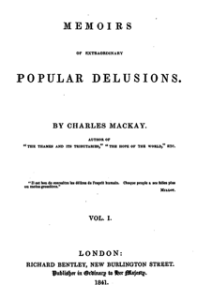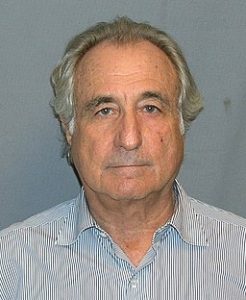
Certificates of Deposit with a 38% APY. Yeah, right.
Cryptocurrency (“Crypto”) has experienced some turbulence lately. Crypto fans reassure us: “It’s only Crypto Winter. It will come roaring back. Just hold on.”
Are the crypto bros right? Not likely. Crypto nuttiness is doomed to end, most likely with a bang, not a whimper. I encountered the above sign touting a 38% APY on a walk in my neighborhood. It is a prime example of hype that serves to hide the truth, just like the man behind the curtain in The Wizard of Oz.

Before explaining this conclusion, let’s address a fundamental misconception: “I know crypto is real and valuable because some of my friends have made money on it. I have made some myself.” Best short answer: As well documented in Charles Mackay’s classic 1841 book Extraordinary Popular Delusions and the Madness of Crowds (1841), in the 17th century many people made money investing in tulips. Until the inevitable crash.
 And, of course, more recently, an investment guru named Bernie Madoff showed many people how to make lots of money. Until the inevitable crash.
And, of course, more recently, an investment guru named Bernie Madoff showed many people how to make lots of money. Until the inevitable crash.
Crypto is today’s slang for cryptocurrency, systems for creating electronic alternatives to cash using a “blockchain,” a supposedly ultra-secure method of recording transactions. It is premised on the use of public key encryption systems. Matt Levine’s Bloomberg article The Crypto Story remains an excellent introduction to crypto basics.
There are technical reasons why the crypto bubble is bursting, including the fact that theoretically unbreakable encryption schemes like those underpinning blockchain have proven to be less than impermeable in practice, as users of Coinbase discovered upon losing fortunes. Attackers go after the weakest link in the chain. This is usually the way in which the algorithm is implemented. Perhaps more ominous, the emergence of a new class of devices called quantum computers threatens to eat the algorithms that underlie at least some crypto implementations for lunch.
Non-Technical Reasons for the Death of Crypto
 You don’t have to be an expert to understand the historic and economic reasons for the impending demise of crypto—and its bastard offspring, NFTs (non-fungible tokens). A preemptive autopsy may help investors recognize similar disasters-in-waiting, worth reviewing the blinking red lights too many missed, so here goes. In brief:
You don’t have to be an expert to understand the historic and economic reasons for the impending demise of crypto—and its bastard offspring, NFTs (non-fungible tokens). A preemptive autopsy may help investors recognize similar disasters-in-waiting, worth reviewing the blinking red lights too many missed, so here goes. In brief:
Crypto is the biggest speculative bubble since Dutch Tulip mania. Like tulips, bitcoins and other forms of cryptocurrency have no intrinsic value. They are not gold or pork bellies, nor backed by the good faith and credit of any government.
James Surowiecki explained why these weak underpinnings are a massive problem:
Crypto valuations are generally founded on a different principle: Intrinsic value doesn’t matter. The value of an asset is not dependent on its use value in the real world or its ability to generate cash in the future. Instead, the value of an asset depends on what people think it’s worth. This is a kind of postmodern vision: There is no “real” value, only narratives of value we collectively construct and choose to believe in, or not. As the crypto and NFT (non-fungible token) investor Nick Tomaino put it last fall, “If the collective group of people on the internet believes something has value, it has value. We are in a world where belief equals value.”
The “belief equals value” dream falls apart when people realize the truth of IT security expert Bruce Schneier‘s observation: “[Cryptocurrency is] not secure. It’s not safe, it’s not reliable, it’s not trustworthy, it’s not even decentralized, it’s not anonymous, it’s helping destroy the planet. I haven’t found one positive use of nothing that couldn’t be done better without it.”
A sane person should be wary when multiple prominent economists, including numerous Nobel prize winners, say cryptocurrency has no intrinsic value. It’s fun (and instructive) to read Nobel winner Paul Krugman’s 12 best quotations about crypto over the past decade. Angus Deaton’s assessment:
It’s better if you’re a criminal, I don’t know why else. The only advantage as far as I can see is you can be a crook [referring to the anonymity that cryptocurrencies allow]. It’s not an accident that people who demand ransoms demand them in bitcoin.”
Donald Trump’s view? He’s on the side of the Nobel Prize winners. In his July 2019 tweet—now deleted with the rest of Trump’s Twitter account—the once (and future?) president tweeted: “I am not a fan of Bitcoin and other cryptocurrencies, which are not money, and whose value is highly volatile and based on thin air.” Not everyone believes Trump is exactly a great economic thinker, but as we used to say where I grew up, “Even a blind hog gets a few acorns.”
Crypto is the most serious recent example of the Greater Fool Theory. As noted by someone who should know, crypto and NFTs are “100% based on greater fool theory.”
The crypto mania phenomenon operates as a sort of distributed Ponzi scheme. No central person or organization runs the scam. There is no single Madoff-type figure. Some sophisticates understand they are selling hype, but there is no central Svengali. Most of those pushing crypto are more victims themselves than grand masterminds.
Has anyone made money on crypto? Sure, plenty of people. That’s part of what makes a Ponzi scheme work. The example of a few early winners misleads investors about what they can expect. Eventually the music stops.
It’s not just economic waifs who lose their way. Madoff’s victims include:
- Carl Shapiro: Founder of women’s clothing brand Kay Windsor
- Fred Wilpon: Former owner of the New York Mets
- Mortimer Zuckerman: Chairman and editor-in-chief of U.S. News & World Report, publisher of the New York Daily News
- Larry Silverstein: Famous for helping develop the World Trade Center
- Leonard Feinstein: Co-founder of Bed, Bath & Beyond
And that’s not counting the celebrity victims, like Matt Damon, LeBron James, Stephen Spielberg and Kevin Bacon.
How can you identify a Ponzi scheme? It’s not exactly a secret. A Wikipedia article provides some good examples, including their tendency to “use vague verbal guises such as ‘hedge futures trading,’ ‘high-yield investment programs’, or ‘offshore investment’ to describe their income strategy.
Given this Ponzi scheme trait, is it surprising that the crypto vendor advertisement in my neighborhood guarantees “Immutable Code with 100% Uptime”? Most likely no one investing in this product understands what that is supposed to mean, let alone the technical aspects of the blockchain. It’s all just technobabble to them.
Crypto has the same allure that Bernie Madoff sold. This is why it has caught the attention of otherwise sophisticated investors. More objective observers like Paul Krugman see things more clearly.
The Psychology of Bad Investments
Why are so many otherwise intelligent people willing to buy into the bubble? A Financial Industry Regulatory Authority (FINRA) advisory provides a clue as to one reason: “[t]he con artists behind [HYIP-type Ponzi schemes] are experts at using social media — including YouTube, Twitter, and Facebook — to lure investors and create the illusion of social consensus that these investments are legitimate.”
Of course it helps when celebrities like Matt Damon and LeBron James can be convinced to endorse crypto publicly. Many of these celebrities feel very differently now.
One intriguing aspect of the crypto puzzle is that many investors understand and tacitly admit that their investments are fundamentally unsound and fragile. They just believe they are so smart they can’t get hurt. They will even say things like, “Crypto is a great investment, you just have to know when to get out.” Of course, this is just an implicit admission that they are relying on finding a greater fool just before the bubble collapses. It’s a personal fable, labeled by Psychology Today as Narcissism and the Myth of Invincibility. As Paul Krugman explains, “Bitcoin plays into a fantasy of self-sufficient individualism, of protecting your family with your personal AR-15, treating your Covid with an anti-parasite drug or urine and managing your financial affairs with privately created money, untainted by institutions like governments or banks.”
Politics play a role in the popularity of crypto. It’s an article of faith in MAGA World (and its Q Anon auxiliary) that what we might call conventional expertise is not helpful and is even often a negative. If Bill Gates (It’s “100% based on greater fool theory.”), Warren Buffett (“If you offered me all the bitcoin in the world for $25, I wouldn’t take it.”) and Paul Krugman (“So crypto has become a large asset class even though nobody can clearly explain what legitimate purpose it’s for.”) criticize crypto, all too many on today’s political scene discount their views altogether, or even consider that criticism from establishment figures even makes crypto more trustworthy.
My favorite example of this came during a discussion with a true MAGA believer. I pointed out that Nobel-winning economist Krugman to supported my view. The Trump acolyte replied—with a straight face—“The Nobel Prize means nothing.”
Steve Bannon’s goal of creating manufactured nihilism has met with considerable success. Today only 41% of Americans trust what they hear from traditional gate-keepers, established news sources. In 1958, about three-quarters of Americans trusted the federal government to do the right thing almost always or most of the time. Today, that view is shared by only 29% of liberals and 9% of conservatives.
In an environment where science is not science and medicine is not medicine, is it a surprise that many Americans consider a politician with a fondness for conspiracy theories but no formal medical training to know more about vaccines than the faculties of all the country’s best medical schools put together? In fact, voters currently view Robert F. Kennedy Jr. more favorably than the President and leading challenger.
The political connection is clear. Only 6% of Democrats opposed COVID-19 vaccinations, but 47% of Republicans said they preferred to avoid the jab.
The partisan connection is not as obvious when crypto is concerned. I have seen no studies showing that MAGA supporters are more likely to buy into crypto. The effect is more subtle. The lack of respect for expertise inoculates true believers against advice from the most objective and reliable sources. When everyone is an expert, no one is an expert.
The power of wishful thinking is another reason why so many people are vulnerable to the crypto scam. We tend to see what we want to see and believe what we want to believe. Nobel Prize winner Robert Schiller noted, “It would be a wonderful story. If only it were true.” Too many people can’t resist the temptation to believe the wild claims about crypto. When someone tells us there’s an easy way to make a lot of money, we often convince ourselves that what they say is true.
This ties into another fascinating aspect of the crypto scene. Significant numbers of investors who have been defrauded or otherwise lost large sums of money stubbornly continue to defend the scammers. A Michelle Singletary column in the Washington Post quoted a classic example:
“I took out at least four loans from different banks to make sure the dream he was talking about, as a family, we were ready,” Victorin said. He still has faith in Alexandre: We believe in this guy,” We believe in our CEO. He is a good guy, a great guy. And we never met somebody like that, very down-to-earth, very respectful, transparent with a lot of charisma.”
Let’s let Nobel Peace Prize winner and Holocaust survivor Elie Wiesel, whose foundation lost $15.2 million to Bernie Madoff, have the last word on the strange allure of bad investments: “We thought he was God. We trusted everything in his hands.”
No doubt many of those touting crypto have lots and lots of charisma. Many of them believe in what they are selling. Sooner or later, and probably sooner, crypto will take its place in the Pantheon of Hype.
Author’s Note: Wendy Leibowitz and Aalia Thomas would probably not agree with all my conclusions in this article, but they have earned my gratitude for refining my thinking about crypto.
